Berg J.M., Tymoczko J.L., Stryer L. Biochemistry
Подождите немного. Документ загружается.

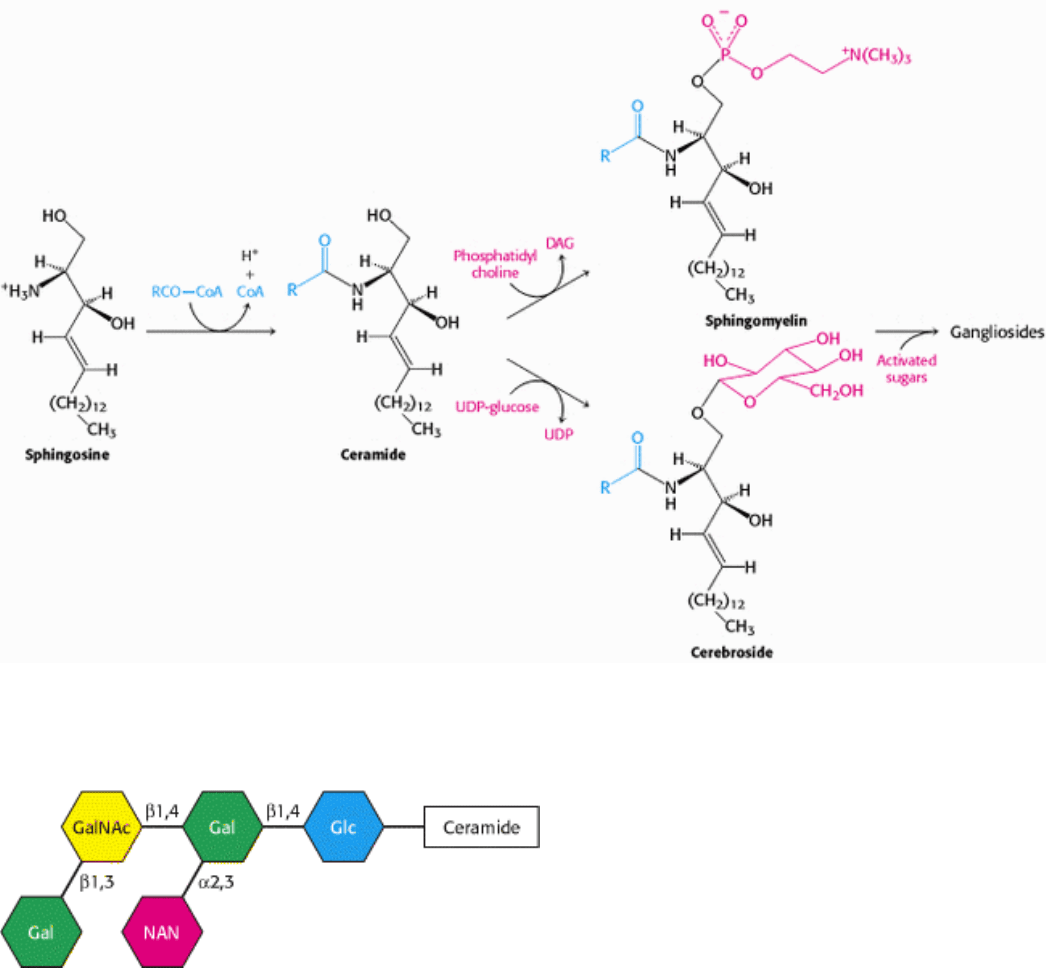
III. Synthesizing the Molecules of Life 26. The Biosynthesis of Membrane Lipids and Steroids 26.1. Phosphatidate Is a Common Intermediate in the Synthesis of Phospholipids and Triacylglycerols
Figure 26.3. Synthesis of Sphingolipids. Sphingosine is converted into ceramide, which is an intermediate in the
formation of sphingomyelin and gangliosides.
III. Synthesizing the Molecules of Life 26. The Biosynthesis of Membrane Lipids and Steroids 26.1. Phosphatidate Is a Common Intermediate in the Synthesis of Phospholipids and Triacylglycerols
Figure 26.4. Ganglioside G
M
1
. This ganglioside consists of five monosaccharides linked to ceramide: one glucose
(Glc) molecule, two galactose (Gal) molecules, one N-acetylgalactosamine (GalNAc) molecule, and one N-
acetylneuraminate (NAN) molecule. The structures of the linkages are indicated.
III. Synthesizing the Molecules of Life 26. The Biosynthesis of Membrane Lipids and Steroids 26.1. Phosphatidate Is a Common Intermediate in the Synthesis of Phospholipids and Triacylglycerols
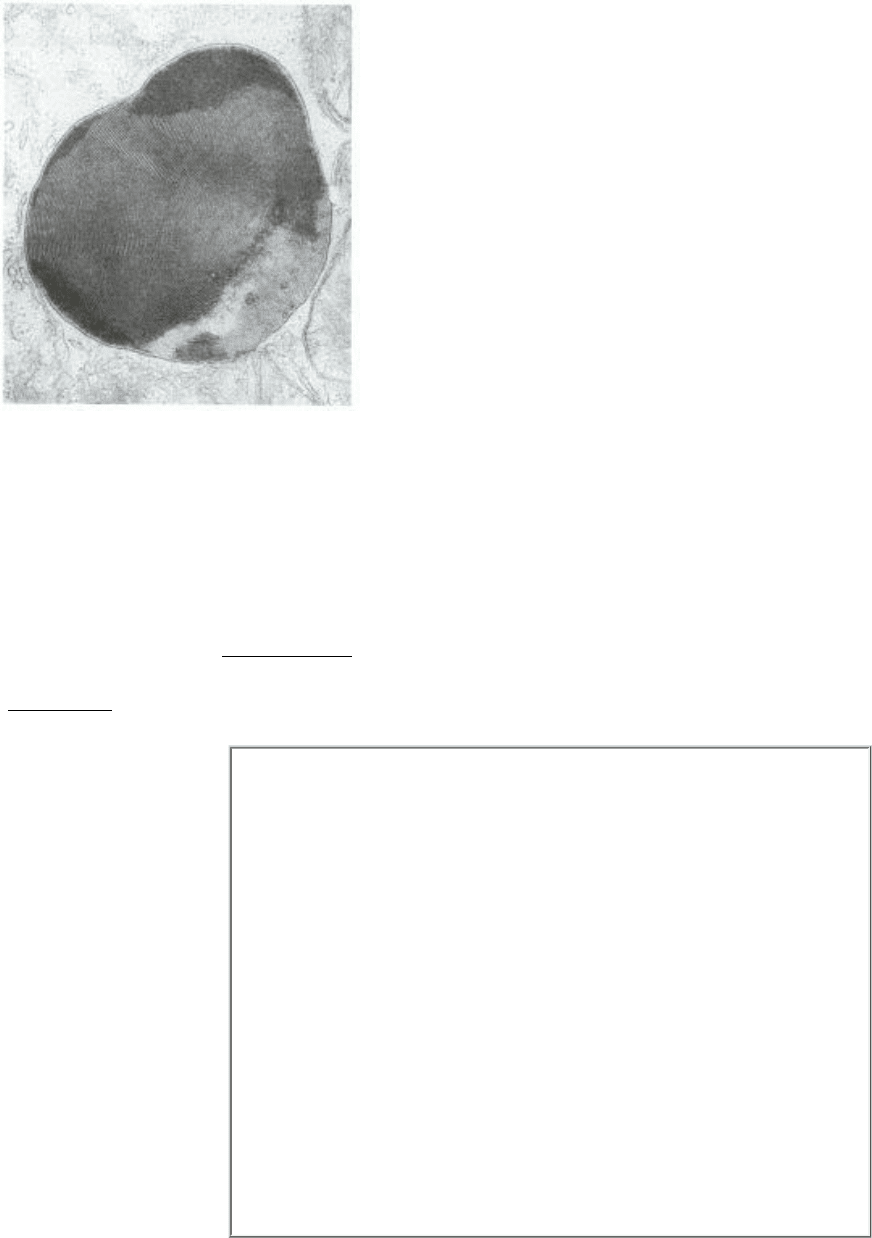
Figure 26.5. Lysosome with Lipids. An electron micrograph of a lysosome containing an abnormal amount of lipid.
[Courtesy of Dr. George Palade.]
III. Synthesizing the Molecules of Life 26. The Biosynthesis of Membrane Lipids and Steroids
26.2. Cholesterol Is Synthesized from Acetyl Coenzyme A in Three Stages
We now turn our attention to the synthesis of the fundamental lipid cholesterol. This steroid modulates the fluidity of
animal cell membranes (Section 12.6.2) and is the precursor of steroid hormones such as progesterone, testosterone,
estradiol, and cortisol. All 27 carbon atoms of cholesterol are derived from acetyl CoA in a three-stage synthetic process
(Figure 26.6).
Cholesterol-
"Cholesterol is the most highly decorated small molecule in biology.
Thirteen Nobel Prizes have been awarded to scientists who devoted
major parts of their careers to cholesterol. Ever since it was isolated
from gallstones in 1784, cholesterol has exerted an almost hypnotic
fascination for scientists from the most diverse areas of science and
medicine. . .. Cholesterol is a Janus-faced molecule. The very
property that makes it useful in cell membranes, namely its absolute
insolubility in water, also makes it lethal."
-Michael Brown and Joseph Goldstein
Nobel Lectures (1985)
© The Nobel Foundation, 1985
1. Stage one is the synthesis of isopentenyl pyrophosphate, an activated isoprene unit that is the key building block of
cholesterol.
2. Stage two is the condensation of six molecules of isopentenyl pyrophosphate to form squalene.
3. In stage three, squalene cyclizes in an astounding reaction and the tetracyclic product is subsequently converted into
cholesterol.
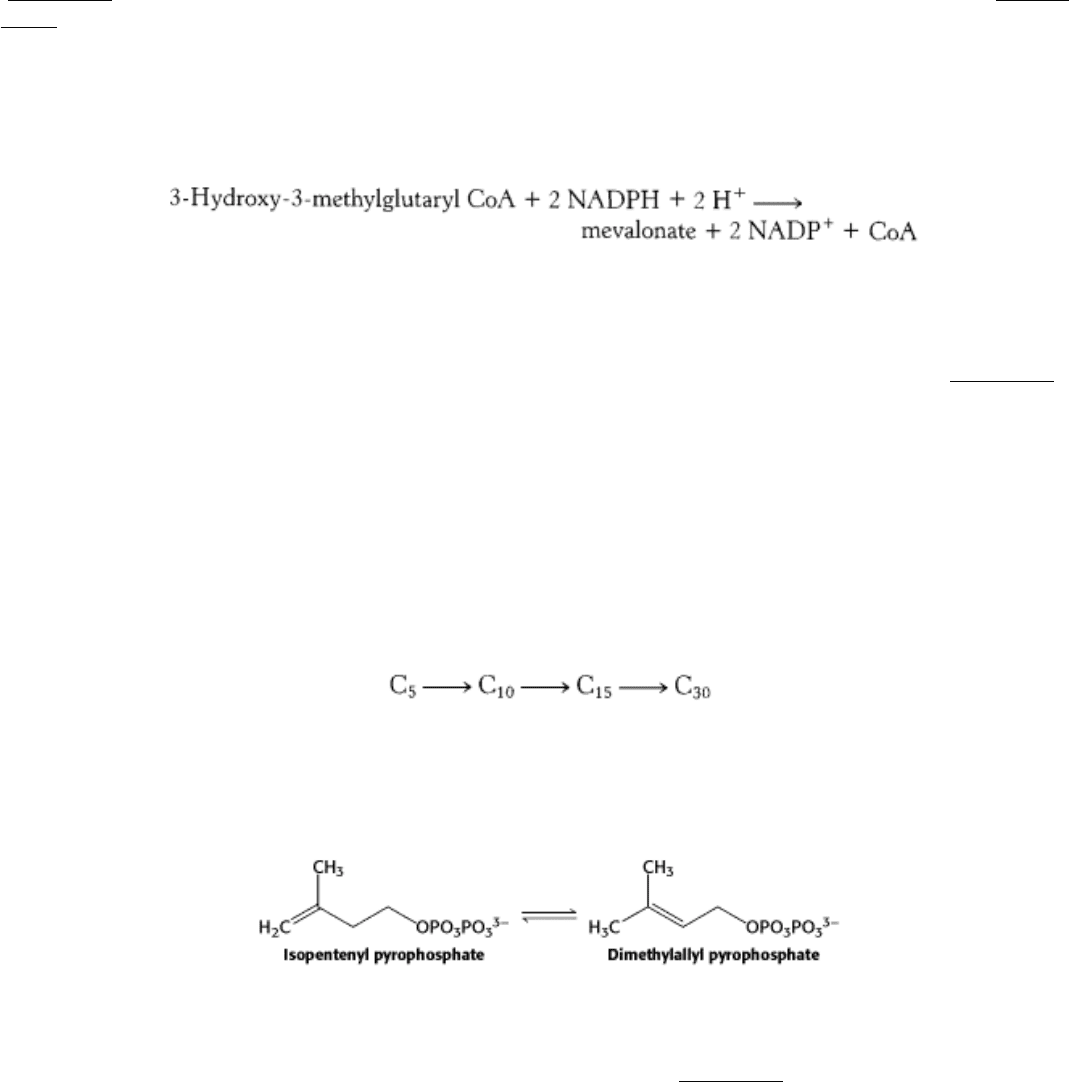
26.2.1. The Synthesis of Mevalonate, Which Is Activated as Isopentenyl Pyrophosphate,
Initiates the Synthesis of Cholesterol
The first stage in the synthesis of cholesterol is the formation of isopentenyl pyrophosphate from acetyl CoA. This set of
reactions, which takes place in the cytosol, starts with the formation of 3-hydroxy-3-methylglutaryl CoA (HMG CoA)
from acetyl CoA and acetoacetyl CoA. This intermediate is reduced to mevalonate for the synthesis of cholesterol
(Figure 26.7). Recall that mitochondrial 3-hydroxy-3-methylglutaryl CoA is processed to form ketone bodies (Section
22.3.5).
The synthesis of mevalonate is the committed step in cholesterol formation. The enzyme catalyzing this irreversible step,
3-hydroxy-3-methylglutaryl CoA reductase (HMG-CoA reductase), is an important control site in cholesterol
biosynthesis, as will be discussed shortly.
HMG-CoA reductase is an integral membrane protein in the endoplasmic reticulum.
Mevalonate is converted into 3-isopentenyl pyrophosphate in three consecutive reactions requiring ATP (Figure 26.8).
Decarboxylation yields isopentenyl pyrophosphate, an activated isoprene unit that is a key building block for many
important biomolecules throughout the kingdoms of life. We will return to a discussion of this molecule later in the
chapter.
26.2.2. Squalene (C
30
) Is Synthesized from Six Molecules of Isopentenyl Pyrophosphate
(C
5
)
Squalene is synthesized from isopentenyl pyrophosphate by the reaction sequence
This stage in the synthesis of cholesterol starts with the isomerization of isopentenyl pyrophosphate to dimethylallyl
pyrophosphate.
These isomeric C
5
units condense to form a C
10
compound: isopentenyl pyrophosphate attacks an allylic carbonium ion
formed from dimethylallyl pyrophosphate to yield geranyl pyrophosphate (Figure 26.9). The same kind of reaction takes
place again: geranyl pyrophosphate is converted into an allylic carbonium ion, which is attacked by isopentenyl
pyrophosphate. The resulting C
15
compound is called farnesyl pyrophosphate. The same enzyme, geranyl transferase,
catalyzes each of these condensations.
The last step in the synthesis of squalene is a reductive tail-to-tail condensation of two molecules of farnesyl
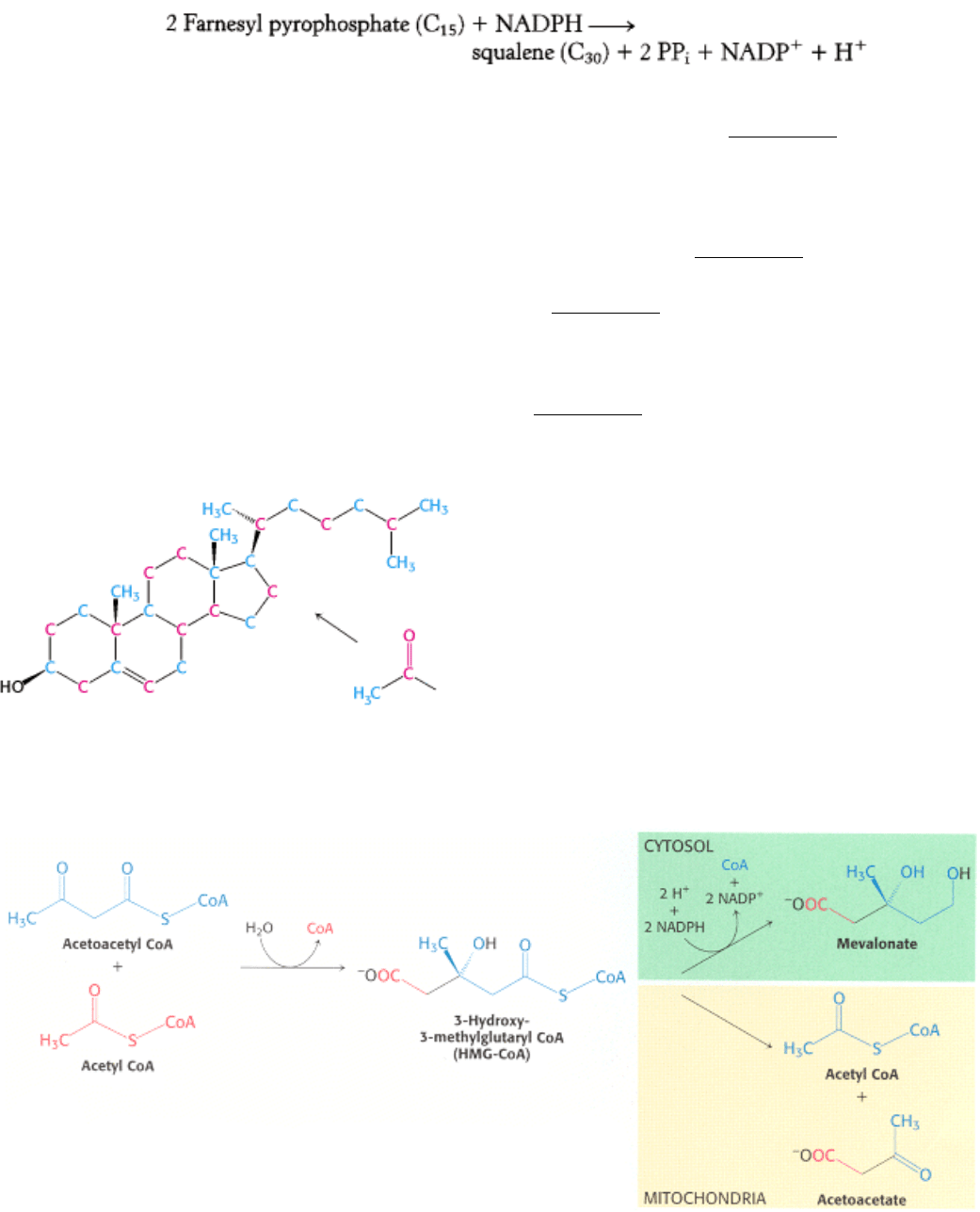
pyrophosphate catalyzed by the endoplasmic reticulum enzyme squalene synthase.
The reactions leading from C
5
units to squalene, a C
30
isoprenoid, are summarized in Figure 26.10.
26.2.3. Squalene Cyclizes to Form Cholesterol
The final stage of cholesterol biosynthesis starts with the cyclization of squalene (Figure 26.11). Squalene is first
activated by conversion into squalene epoxide (2,3-oxidosqualene) in a reaction that uses O
2
and NADPH. Squalene
epoxide is then cyclized to lanosterol by oxidosqualene cyclase (Figure 26.12). This remarkable transformation proceeds
in a concerted fashion. The enzyme holds squalene epoxide in an appropriate conformation and initiates the reaction by
protonating the epoxide oxygen. The carbocation formed spontaneously rearranges to produce lanosterol. Lanosterol is
converted into cholesterol in a multistep process by the removal of three methyl groups, the reduction of one double
bond by NADPH, and the migration of the other double bond (Figure 26.13).
III. Synthesizing the Molecules of Life 26. The Biosynthesis of Membrane Lipids and Steroids 26.2. Cholesterol Is Synthesized from Acetyl Coenzyme A in Three Stages
Figure 26.6. Labeling of Cholesterol. The results of isotope-labeling experiments reveal the source of carbon atoms in
cholesterol synthesized from acetate labeled in its methyl group (blue) or carboxylate atom (red).
III. Synthesizing the Molecules of Life 26. The Biosynthesis of Membrane Lipids and Steroids 26.2. Cholesterol Is Synthesized from Acetyl Coenzyme A in Three Stages
Figure 26.7. Fates of 3-Hydroxy-3-Methylglutaryl CoA. In the cytosol, HMG-CoA is converted into mevalonate. In
mitochondria, it is converted into acetyl CoA and acetoacetate.

III. Synthesizing the Molecules of Life 26. The Biosynthesis of Membrane Lipids and Steroids 26.2. Cholesterol Is Synthesized from Acetyl Coenzyme A in Three Stages
Figure 26.8. Synthesis of Isopentenyl Pyrophosphate. This activated intermediate is formed from mevalonate in three
steps, the last of which includes a decarboxylation.
III. Synthesizing the Molecules of Life 26. The Biosynthesis of Membrane Lipids and Steroids 26.2. Cholesterol Is Synthesized from Acetyl Coenzyme A in Three Stages
Figure 26.9. Condensation Mechanism in Cholesterol Synthesis. The mechanism for joining dimethylallyl
pyrophosphate and isopentenyl pyrophosphate to form geranyl pyrophosphate. The same mechanism is used to add an
additional isopentenyl pyrophosphate to form farnesyl pyrophosphate.
III. Synthesizing the Molecules of Life 26. The Biosynthesis of Membrane Lipids and Steroids 26.2. Cholesterol Is Synthesized from Acetyl Coenzyme A in Three Stages

Figure 26.10. Squalene Synthesis. One molecule of dimethyallyl pyrophosphate and two molecules of isopentenyl
pyrophosphate condense to form farnesyl pyrophosphate. The tail-to-tail coupling of two molecules of farnesyl
pyrophosphate yields squalene.
III. Synthesizing the Molecules of Life 26. The Biosynthesis of Membrane Lipids and Steroids 26.2. Cholesterol Is Synthesized from Acetyl Coenzyme A in Three Stages
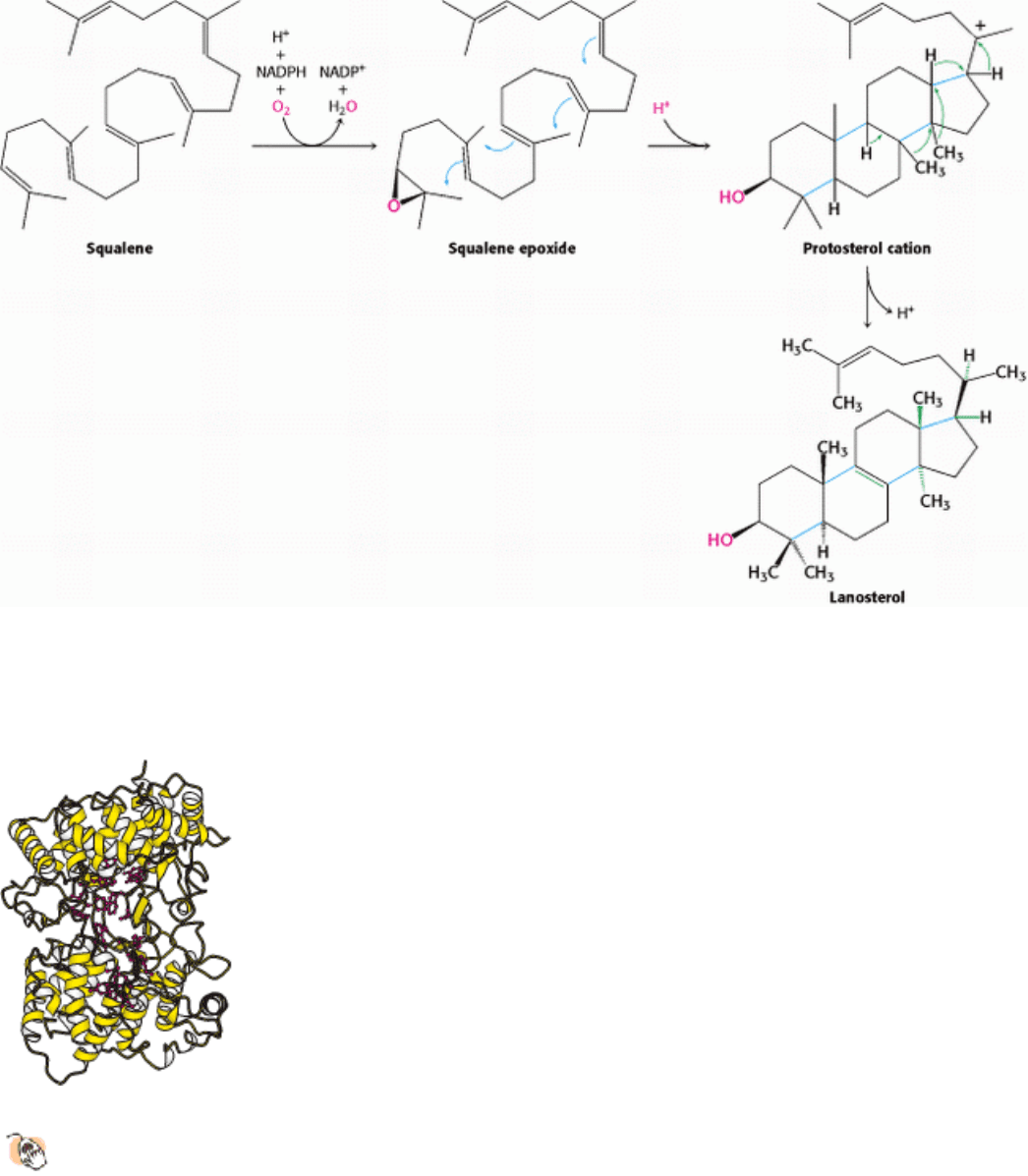
Figure 26.11. Squalene Cyclization. The formation of the steroid nucleus from squalene begins with the formation of
squalene epoxide. This intermediate is protonated to form a carbocation that cyclizes to form a tetracyclic structure,
which rearranges to form lanosterol.
III. Synthesizing the Molecules of Life 26. The Biosynthesis of Membrane Lipids and Steroids 26.2. Cholesterol Is Synthesized from Acetyl Coenzyme A in Three Stages
Figure 26.12. Oxidosqualene Cyclase.
The structure of an enzyme homologous to oxidosqualene cyclase shows a
central cavity lined primarily with hydrophobic side chains (shown in red) in which the cyclization reaction takes
place.
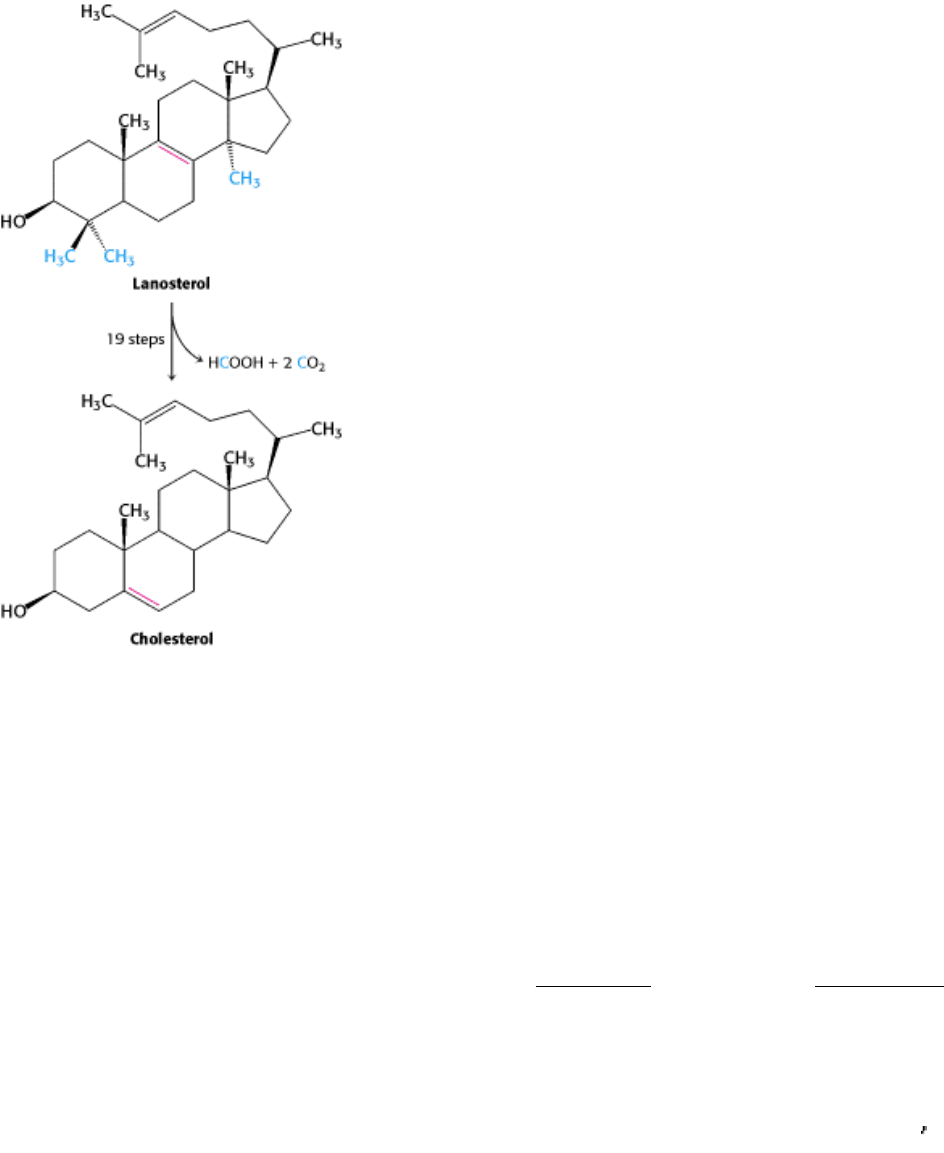
III. Synthesizing the Molecules of Life 26. The Biosynthesis of Membrane Lipids and Steroids 26.2. Cholesterol Is Synthesized from Acetyl Coenzyme A in Three Stages
Figure 26.13. Cholesterol Formation. Lanosterol is converted into cholesterol in a complex process.
III. Synthesizing the Molecules of Life 26. The Biosynthesis of Membrane Lipids and Steroids
26.3. The Complex Regulation of Cholesterol Biosynthesis Takes Place at Several
Levels
Cholesterol can be obtained from the diet or it can be synthesized de novo. An adult on a low-cholesterol diet typically
synthesizes about 800 mg of cholesterol per day. The liver is the major site of cholesterol synthesis in mammals,
although the intestine also forms significant amounts. The rate of cholesterol formation by these organs is highly
responsive to the cellular level of cholesterol. This feedback regulation is mediated primarily by changes in the amount
and activity of 3-hydroxy-3-methylglutaryl CoA reductase (Figure 26.14). As discussed in Section 26.2.1, this enzyme
catalyzes the formation of mevalonate, the committed step in cholesterol biosynthesis. HMG CoA reductase is controlled
in multiple ways:
1. The rate of synthesis of reductase mRNA is controlled by the sterol regulatory element binding protein (SREBP). This
transcription factor binds to a short DNA sequence called the sterol regulatory element (SRE) on the 5 side of the
reductase gene. In its inactive state, the SREBP is anchored to the endoplasmic reticulum or nuclear membrane. When
cholesterol levels fall, the amino-terminal domain is released from its association with the membrane by two specific
proteolytic cleavages. The released protein migrates to the nucleus and binds the SRE of the HMG-CoA reductase gene,
as well as several other genes in the cholesterol biosynthetic pathway, to enhance transcription. When cholesterol levels
rise, the proteolytic release of the SREBP is blocked, and the SREBP in the nucleus is rapidly degraded. These two
events halt the transcription of the genes of the cholesterol biosynthetic pathways.
2. The rate of translation of reductase mRNA is inhibited by nonsterol metabolites derived from mevalonate as well as by
dietary cholesterol.

3. The degradation of the reductase is stringently controlled. The enzyme is bipartite: its cytosolic domain carries out
catalysis and its membrane domain senses signals that lead to its degradation. The membrane domain may undergo a
change in its oligomerization state in response to increasing concentrations of sterols such as cholesterol, making the
enzyme more susceptible to proteolysis. Homologous sterol-sensing regions are present in the protease that activates
SREBP. The reductase may be further degraded by ubiquitination and targeting to the 26S proteasome under some
conditions. A combination of these three regulatory devices can regulate the amount of enzyme over a 200-fold range.
4. Phosphorylation decreases the activity of the reductase. This enzyme, like acetyl CoA carboxylase (which catalyzes
the committed step in fatty acid synthesis, Section 22.5), is switched off by an AMP-activated protein kinase. Thus,
cholesterol synthesis ceases when the ATP level is low.
As we will see shortly, all four regulatory mechanisms are modulated by receptors that sense the presence of cholesterol
in the blood.
26.3.1. Lipoproteins Transport Cholesterol and Triacylglycerols Throughout the
Organism
Cholesterol and triacylglycerols are transported in body fluids in the form of lipoprotein particles. Each particle consists
of a core of hydrophobic lipids surrounded by a shell of more polar lipids and apoproteins. The protein components of
these macromolecular aggregates have two roles: they solubilize hydrophobic lipids and contain cell-targeting signals.
Lipoprotein particles are classified according to increasing density (Table 26.1): chylomicrons, chylomicron remnants,
very low density lipoproteins (VLDL), intermediate-density lipoproteins (IDL), low-density lipoproteins (LDL), and high-
density lipoproteins (HDL). Ten principal apoproteins have been isolated and characterized. They are synthesized and
secreted by the liver and the intestine.
Triacylglycerols, cholesterol, and other lipids obtained from the diet are carried away from the intestine in the form of
large chylomicrons (180
500 nm in diameter; Section 22.1.2). These particles have a very low density (d<0.94 g cm
-3
)
because triacylglycerols constitute ~99% of their content. Apolipoprotein B-48 (apo B-48), a large protein (240 kd),
forms an amphipathic spherical shell around the fat globule; the external face of this shell is hydrophilic. The
triacylglycerols in chylomicrons are released through hydrolysis by lipoprotein lipases. These enzymes are located on
the lining of blood vessels in muscle and other tissues that use fatty acids as fuels and in the synthesis of fat. The liver
then takes up the cholesterol-rich residues, known as chylomicron remnants.
The liver is a major site of triacylglycerol and cholesterol synthesis (Figure 26.15). Triacylglycerols and cholesterol in
excess of the liver's own needs are exported into the blood in the form of very low density lipoproteins (d<1.006 g cm
-3
).
These particles are stabilized by two lipoproteins apo B-100 and apo E (34 kd). Apo B-100, one of the largest proteins
known (513 kd), is a longer version of apo B-48. Both apo B proteins are encoded by the same gene and produced from
the same initial RNA transcript. In the intestine, RNA editing (Section 28.3.2) modifies the transcript to generate the
mRNA for apo B-48, the truncated form. Triacylglycerols in very low density lipoproteins, as in chylomicrons, are
hydrolyzed by lipases on capillary surfaces. The resulting remnants, which are rich in cholesteryl esters, are called
intermediate-density lipoproteins(1.006 < d < 1.019 g cm
-3
). These particles have two fates. Half of them are taken up by
the liver for processing, and half are converted into low-density lipoprotein (1.019 < d < 1.063 g cm
-3
) by the removal of
more triacylglycerol.
Low-density lipoprotein is the major carrier of cholesterol in blood. This lipoprotein particle has a diameter of 22 nm
and a mass of about 3 million daltons (Figure 26.16). It contains a core of some 1500 esterified cholesterol molecules;
the most common fatty acyl chain in these esters is linoleate, a polyunsaturated fatty acid. A shell of phospholipids and
unesterified cholesterols surrounds this highly hydrophobic core. The shell also contains a single copy of apo B-100,
which is recognized by target cells. The role of LDL is to transport cholesterol to peripheral tissues and regulate de
novo cholesterol synthesis at these sites, as described in Section 26.3.3. A different purpose is served by high-density
lipoprotein (1.063 < d < 1.21 g cm
-3
), which picks up cholesterol released into the plasma from dying cells and from
membranes undergoing turnover. An acyltransferase in HDL esterifies these cholesterols, which are then either rapidly

shuttled to VLDL or LDL by a specific transfer protein or returned by HDL to the liver.
26.3.2. The Blood Levels of Certain Lipoproteins Can Serve Diagnostic Purposes
High serum levels of cholesterol cause disease and death by contributing to the formation of atherosclerotic
plaques in arteries throughout the body. This excess cholesterol is present in the form of the low density
lipoprotein particle, so-called "bad cholesterol."The ratio of cholesterol in the form of high density lipoprotein,
sometimes referred to as "good cholesterol," to that in the form of LDL can be used to evaluate susceptibility to the
development of heart disease. For a healthy person, the LDL/HDL ratio is 3.5.
High-density lipoprotein functions as a shuttle that moves cholesterol throughout the body. HDL binds and esterifies
cholesterol released from the peripheral tissues and then transfers cholesteryl esters to the liver or to tissues that use
cholesterol to synthesize steroid hormones. A specific receptor mediates the docking of the HDL to these tissues. The
exact nature of the protective effect of HDL levels is not known; however, a possible mechanism is discussed in Section
26.3.5.
26.3.3. Low-Density Lipoproteins Play a Central Role in Cholesterol Metabolism
Cholesterol metabolism must be precisely regulated to prevent atherosclerosis. The mode of control in the liver, the
primary site of cholesterol synthesis, has already been discussed: dietary cholesterol reduces the activity and amount of 3-
hydroxy-3-methylglutaryl CoA reductase, the enzyme catalyzing the committed step. The results of studies by Michael
Brown and Joseph Goldstein are sources of insight into the control of cholesterol metabolism in nonhepatic cells. In
general, cells outside the liver and intestine obtain cholesterol from the plasma rather than synthesizing it de novo.
Specifically, their primary source of cholesterol is the low-density lipoprotein. The process of LDL uptake, called
receptor-mediated endocytosis, serves as a paradigm for the uptake of many molecules.
The steps in the receptor-mediated endocytosis of LDL are as follows (see Figure 12.40).
1. Apolipoprotein B-100 on the surface of an LDL particle binds to a specific receptor protein on the plasma membrane
of nonhepatic cells. The receptors for LDL are localized in specialized regions called coated pits, which contain a
specialized protein called clathrin.
2. The receptor-LDL complex is internalized by endocytosis, that is, the plasma membrane in the vicinity of the complex
invaginates and then fuses to form an endocytic vesicle (Figure 26.17).
3. These vesicles, containing LDL, subsequently fuse with lysosomes, acidic vesicles that carry a wide array of
degradative enzymes. The protein component of the LDL is hydrolyzed to free amino acids. The cholesteryl esters in the
LDL are hydrolyzed by a lysosomal acid lipase. The LDL receptor itself usually returns unscathed to the plasma
membrane. The round-trip time for a receptor is about 10 minutes; in its lifetime of about a day, it may bring many LDL
particles into the cell.
4. The released unesterified cholesterol can then be used for membrane biosynthesis. Alternatively, it can be reesterified
for storage inside the cell. In fact, free cholesterol activates acyl CoA:cholesterol acyltransferase (ACAT), the enzyme
catalyzing this reaction. Reesterified cholesterol contains mainly oleate and palmitoleate, which are monounsaturated
fatty acids, in contrast with the cholesterol esters in LDL, which are rich in linoleate, a polyunsaturated fatty acid (see
Table 24.1). It is imperative that the cholesterol be reesterified. High concentrations of unesterified cholesterol disrupt
the integrity of cell membranes.
The synthesis of LDL receptor is itself subject to feedback regulation. The results of studies of cultured fibroblasts show
that, when cholesterol is abundant inside the cell, new LDL receptors are not synthesized, and so the uptake of
additional cholesterol from plasma LDL is blocked. The gene for the LDL receptor, like that for the reductase, is
regulated by SREBP, which binds to a sterol regulatory element that controls the rate of mRNA synthesis.
